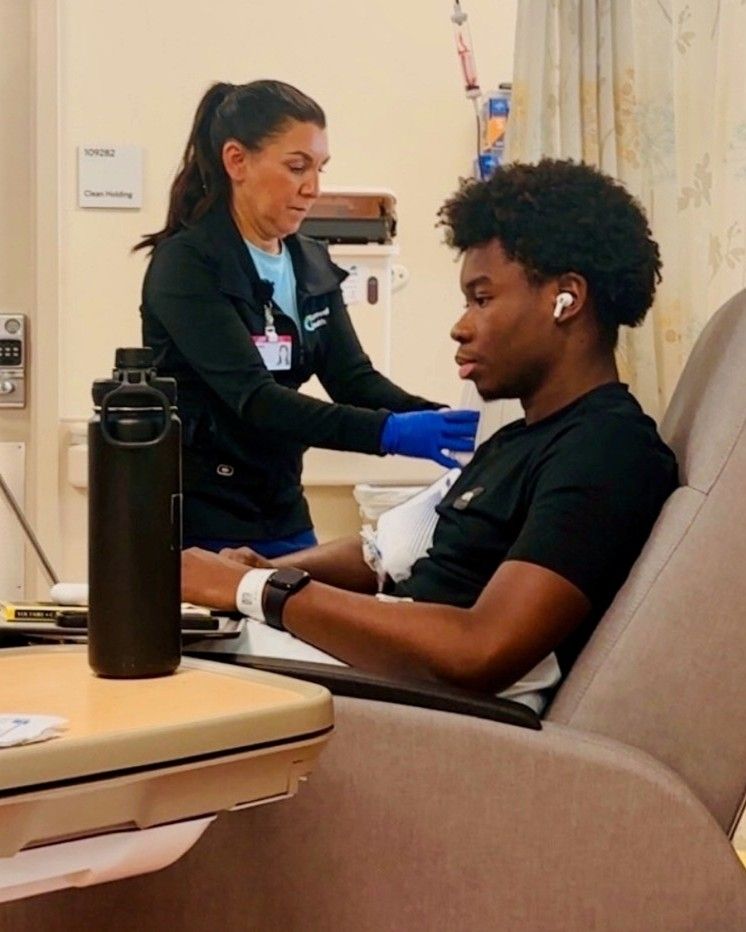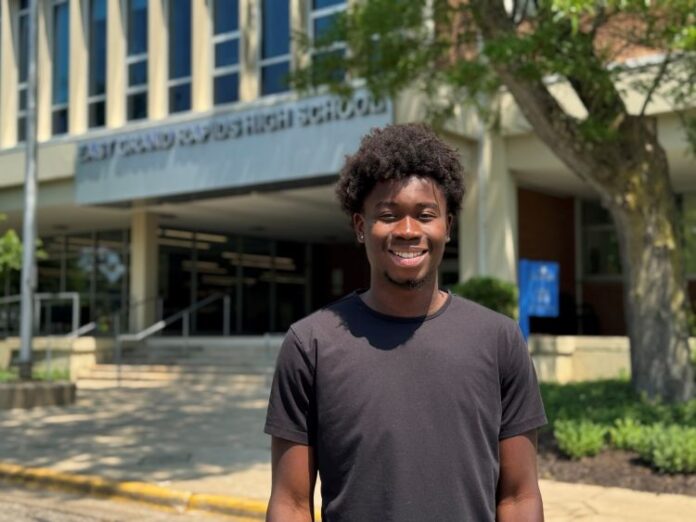East Grand Rapids — You wouldn’t know it to look at him, nor would you guess it based on his excellent grades, but Sam Greenway spent much of his senior year in pain he likens to “glass shards flowing through your veins.”
The recent East Grand Rapids High School graduate has sickle cell anemia, a disorder marked by misshapen, rigid red blood cells, which stick together and block the flow of oxygen to the rest of the body. This results in fatigue, inflammation, infection and extreme pain, which is the symptom Sam has struggled with the most.
“It’s kind of just this super-sharp, intense pain, and it’s just there,” Sam said.
For most of his life, Sam considered himself pretty lucky. His condition only flared up a couple times a year; while that would sometimes result in a hospitalization, the overall effect on his quality of life was pretty minimal.
That changed during Sam’s senior year. And though he’s since started a new treatment that’s producing some promising results, the past year has been a struggle.
‘Now that I’m getting better, I’m back to seeing a bright future and I have high hopes.’
— senior Sam Greenway
Living with Pain
Sickle cell is a hereditary illness, and Sam has lived with it his entire life. He came to the U.S. from Haiti at age 2 after being adopted. Upon arrival, he said, he was in pretty bad shape, with sepsis, pneumonia and other health complications.
“I was pretty sick, and my parents had no idea what was going on,” Sam said. “I was in the hospital many times when I was little.”
Eventually he was tested for sickle cell and the results came back positive. The diagnosis helped Sam’s doctors effectively treat him and equipped his family with the tools to help mitigate pain.

For years, the condition was, for the most part, under control, and Sam only experienced two or three painful flare-ups, or crises, per year. When Sam did have a crisis — the word used to describe sickled red blood cells restricting blood flow and causing pain — they tended not to last long. And the pain was manageable using over-the-counter medication like ibuprofen.
In September of his senior year, though, something shifted. The pain was worse, the episodes lasted longer, and tamer pain medications were no longer cutting it.
“It’s been ongoing and it’s kind of developed into a chronic situation,” Sam said. “It’s still going now. I’ve been kind of going through school in pain.”
Sam’s doctors saw no other option beyond prescribing opioid painkillers like oxycodone, which Sam has used multiple times a day for much of the past year.
Regrettably, Sam said, opioids are “the main way to treat sickle cell pain — the most effective.”
Finding a Treatment that Works
Doctors had no real explanation for the increased frequency and severity of Sam’s sickle cell crises, other than that the condition is known to worsen after age 18.
Sam and his doctors considered various treatment options and performed many tests. Among them was a sleep study, because Sam was waking up in the night and gasping for air. Thanks to this study, he received a diagnosis of severe obstructive sleep apnea, which is “pretty common with sickle cell,” Sam said.
Doctors recommended a tonsillectomy for the sleep apnea. But the surgery this winter led to a five-day hospital stint due to complications from the sickle cell, even after Sam had a precautionary pre-surgery blood transfusion to mitigate the risks. Plus, while his sleeping improved, his pain did not. If anything, it may have gotten worse, Sam said.
Eventually, he was referred to a new hematologist, who suggested monthly infusions of a drug that “tries to prevent (blood cells) from sticking together, which is supposed to reduce the amount of crises,” Sam said.
The improvement was far from instantaneous. In fact, for the first few months, Sam didn’t have much confidence that the treatment was working.
“Me and my mom were just told to be patient by the doctors, which is really frustrating,” he said.
But by early June, after a few months of the treatments, Sam said they seemed to finally be making a difference.
“The past few weeks I’ve really seen improvement,” he said. “My energy’s way up, my fatigue’s way down. I just feel, overall, way better. … I just wish it (had happened) sooner.”
He’s even been able to cut way back on his use of prescription pain medication, which he hopes he’ll be able to stop using entirely sometime soon.
Motivated by Community
Somehow, Sam has never really let his condition interfere with his academic performance, though he acknowledged that it’s harder to get his work done when he’s in the midst of a pain crisis.
“When I’m having a bad episode, it takes over and it’s hard to concentrate, and it’s kind of the only thing I can focus on,” he said.

But he’s managed, even when his health was at its worst. He remembers having friends bring him schoolwork in the hospital, and working on physics and math homework while receiving blood and medication infusions.
Sam said he’s grateful to his parents and the East community for giving him the motivation and the flexibility to stay on top of his coursework.
“I appreciate my parents for making the importance of school known to me,” he said. “I want to thank my teachers, too, because they were super supportive through all of this.”
The appreciation is mutual. EGRHS Principal Alex Schukow called Sam a “wonderful student and human being.”
“In the classroom, he is engaged, organized and accountable,” Schukow said. “He helps classmates when they need it and looks out for others. He is a leader who leads with quiet strength, resilience and respect.”
In the fall, Sam will attend the University of Michigan, where he plans to study mechanical engineering. The campus has a clinic where he’ll be able to continue receiving infusions and stay on top of his condition.
Though the past year has been challenging, Sam is feeling positive about what’s ahead.
“When I was in the middle of it, I knew that I would get better, but it kind of just felt like it was never going to happen, really,” he said. “It was kind of just this hopeless feeling of all the things we tried not working.
“But now that I’m getting better, I’m back to seeing a bright future and I have high hopes.”
Read more from East Grand Rapids:
• Zoo visitors help youngest learners cap off curriculum
• Tree identification project will be used ‘for years to come’









